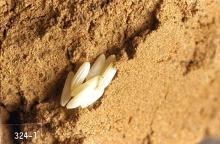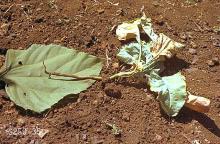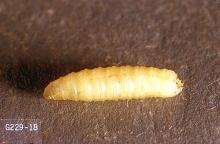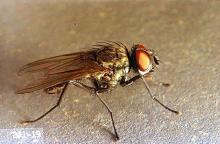Delia brassicae
Pest description, crop damage and life history
See:
Common Pests of Vegetable Crops
Pest monitoring Once the crop emerges, watch for wilting, lighter green plants, or reduced growth that may indicate a maggot infestation. Pull up affected plants, and check roots and soil to confirm the presence of maggots. If several rows of seedling plants are infested, plants may be removed and rows replanted. Drenching with insecticide is also an option, but such treatments are difficult, costly, and may not be adequate.
If roots are tunneled but no maggots are present, maggots have left the roots to pupate, and insecticide treatments would be of little value.
Sticky traps and sweep nets also can be used to monitor the adult fly.
Management-biological control
Rove beetles prey on maggot eggs and young larvae. Rove larvae parasitize the pupa stage of the maggot. The parasitic wasp, Trybliographa rapae, lays its eggs in the maggot larvae if the larvae are close enough to the soil surface. Biological controls cannot be counted on to provide adequate control.
Management-cultural control
Where maggots are a perennial problem, grow seedlings for transplants in fumigated soil in the greenhouse or under frames of clear plastic. Avoid hardening transplants near infested fields. Direct-seeded crops may avoid some injury when a set of drag chains is attached behind the planter to eliminate the moisture gradient in the seedrow. It is believed that adult flies can locate the seed row for egglaying by honing in on the higher moisture levels created when the soil is overturned for planting.
Older plants may outgrow moderate cabbage maggot populations if maintained with a careful irrigation schedule. Always disc under crop residues immediately after harvest. Maggots can survive for some time in crop residue. Do not follow susceptible crops with susceptible crops unless sufficient time has passed for the residue to dry or decompose completely.
Row covers using various fabrics, such as Remay, have proven very effective in preventing egg laying around the base of the plants. Row covers are ineffective if the crop is grown on land that has been previously infested heavily by the maggot, since overwintering flies will have emerged under the row covers.
Management-chemical control: HOME USE
- azadirachtin (as a mix with pyrethrins)-Some formulations are OMRI-listed for organic use.
- pyrethrins (often combined with other ingredients)-Some formulations are OMRI-listed for organic use.
- zeta-cypermethrin
Management-chemical control: COMMERCIAL USE
Every year, in areas where cabbage maggot causes economic injury, treat spring planted or transplanted crops with a band of insecticide at the base of the plant at the time of planting or transplanting. Control of adult flies is generally not recommended. Later sprays cannot be relied upon to control the pest effectively. Treat seedbeds for transplanted crops with an insecticide.
Transplant application
- chlorantraniliprole (Coragen 2ee) at 5 fl oz per acre as a transplant water treatment. PHI 3 days. REI 4 hr. Do not exceed 0.2 lb ai/A chlorantraniliprole per year. Do not exceed 0.132 lb ai/A of Coragen per crop by any treatment combination.
- diazinon (Diazinon 50W) at 0.5 to 1 lb ai per 200 gallons of transplant water. Apply in transplant water as a drench application when 200-300 gals of water are used per acre. Apply labeled rate by tractor-mounted sprayer equipped with drop nozzles to direct spray to the base of the plant. Note: Transplant water treatments may result in stand reduction due to plant stress at time of transplanting. Refer to label.
- spinetoram (Radiant SC)-Consult label for rates according to row spacing. Suppression only.
- At plant or post plant soil application
- bifenthrin/IBA (Empower 2) at 0.04 to 0.1 lb ai/A. PHI 7 days. REI 5 days. Retreatment interval 7 days. Do not exceed 0.5 lb ai/A per season. Refer to label. Empower 2 no longer registered for use in OR.
- spinetoram (Radiant SC)-Under high root maggot pressure direct the spray in a narrow band at the base of the plants. Consult label for rates.
- Preplant incorporation application for direct seeded or transplanted crop
- bifenthrin (Capture LFR) at 0.04 to 0.08 lb ai/A at planting in furrow or broadcast to soil surface. Do not exceed 0.1 lb ai/A per season at plant application. Refer label instructions.
- bifenthrin (Brigade WSB) at 0.05 to 0.1 lb ai/A in-furrow with seed or transplant. REI 12 hr.
- diazinon (Diazinon 50W) at 2 to 3 lb ai/A (minimum 10 gal/A). Broadcast just before planting and immediately incorporate into the top 3-4 inches of soil.
- spinetoram (Radiant SC)-Consult label for rates according to row spacing. Suppression only.




